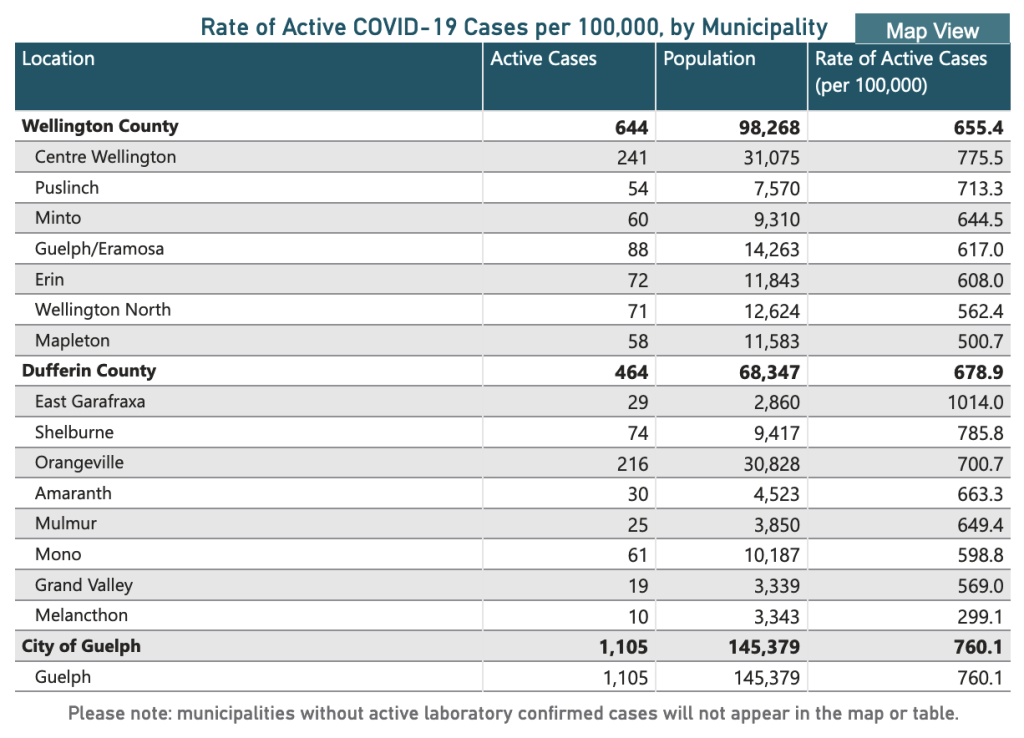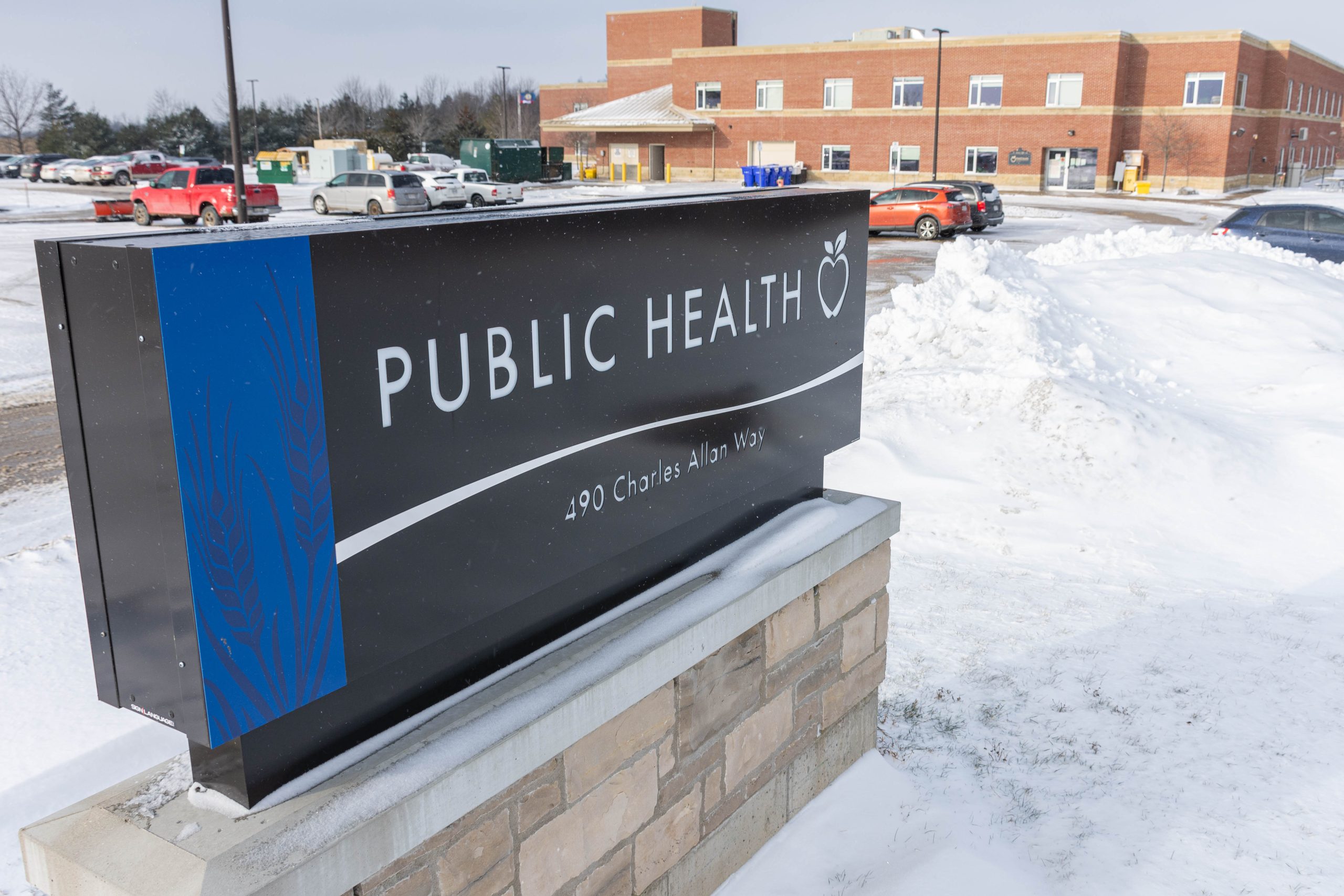WELLINGTON COUNTY – Wellington-Dufferin-Guelph Public Health (WDGPH) has reported 640 new COVID-19 cases between Jan. 7 and 9.
As of Jan. 10, active cases sat at 2,318 after hitting an all-time high of 2,972 cases on Jan. 4.
The case rate per 100,000 population was 427.6 on Jan. 8, a decrease from 725.3 observed between Dec. 27 and Jan. 2.
The rate of COVID-19 tests returning positive for the virus was 25.3% on Jan. 6, trending downward after reaching 32.1 on Dec. 31.
The region’s effective reproduction number, used to measure how many additional cases spread or result from a single case, sat at 1.13 as of Jan. 8. A value of one or above means cases will increase; below one and spread will eventually cease.
The number of people hospitalized with COVID-19 in the region has doubled since Dec. 29 when 13 COVID-positive persons were in region hospitals.
As of Jan. 7 there were 26 people hospitalized with the virus, of which two were admitted to an ICU – down from four in an ICU on Dec. 29. That is an all-time high for COVID hospitalizations in the region, surpassing the previous high of 24 set in April of 2021, when nine people were in an ICU.
Vaccination status of those hospitalized are not disclosed locally.
According to provincial data, as of the morning on Jan. 10, there are 580 unvaccinated persons hospitalized with COVID-19 across the province, of which 123 are in an ICU. In contrast, there are 1,490 two-dose vaccinated persons hospitalized across the province, of which 137 are in an ICU.
Considering about 83% of eligible Ontarians are vaccinated with at least two doses, data from the Ontario Science Table indicates that as of Jan. 10, unvaccinated individuals are more than four times more likely to be hospitalized with COVID-19 and over 10 times more likely to end up in an ICU than those who are vaccinated.
Omicron variant breakdown
WDGPH identified the region’s first case of the COVID-19 Omicron variant on Dec. 9 in a fully-vaccinated Guelph male aged 12 to 20.
According to Public Health Ontario (PHO) data, as of Dec. 29 (the latest available) there have been 574 Omicron cases identified by either “complete genomic analysis” or “S-gene target failure” in the health region.
PHO cautions case counts are an “underestimate of the true number of individuals with COVID-19” in the province due to recent changes narrowing testing eligibility to only high-risk individuals who are symptomatic and/or are at risk of severe illness from COVID-19, meaning not all positive cases are known to health officials.
In recent weeks Ontarians have also reported difficulty in accessing both rapid antigen and PCR testing.
WDGPH estimates Omicron represents 4.8% of all COVID-19 cases between Jan. 1 and Jan. 7 in the health region.
Local trends
Wellington County had 232 newly-confirmed cases over the Jan. 7 to 9 reporting period, bringing the total active cases to 644 in the county as of Jan. 10 and breaking the previous all-time high of 604 recorded on Jan. 4.
In previous waves the county record was 122, set in April of 2021.
There are 1,105 active cases in Guelph and 464 in Dufferin County as of Jan. 10.
There have been two additional COVID-related deaths in the region reported by WDGPH as of Jan. 10.
According to WDGPH spokesperson Danny Williamson, a young girl under the age of 10 and a woman in her 20s – both residents of Wellington County – have died while infected with the coronavirus.
The number of people who have died with the virus has increased to 131 people, including 41 from the county, as of Jan. 10.

Municipality-specific active COVID-19 case counts as of Jan. 10, 2022. (WDGPH image)
Vaccinations
Since Jan. 4, another 1,584 people have become two-dose vaccinated in the WDGPH region, bringing the total as of Jan. 10 to 244,100 or 82.7% of the population aged five or older.
There are 16,503 people aged five or older in the region who have received a first dose, as of Jan. 10.
According to Ontario’s COVID-19 Advisory Science Table data, as of Jan. 10, there were 1,060 new cases every day per million people in those unvaccinated, and 789 cases per day in those with at least two doses.
The data concludes there’s a 25.5% reduction in the risk of contracting a case with two vaccine doses. The reduction in the risk of being hospitalized with two doses is 77%.
In Wellington County 81.7% of eligible residents are two-dose vaccinated as of Jan. 5.
Less than 70% of residents in Mapleton are vaccinated, and it remains the only municipality within the county below that threshold.
Across the region, according to WDGPH data, there are an estimated 11,363 high school students who are vaccinated with two doses; 287 with only a single dose; and 2,008 students who have not yet received a single dose.
In elementary schools in the WDGPH catchment area, there are an estimated 30,033 students who are now eligible for vaccination, according to WDGPH data.
Of that group, 10,662 elementary students are at least vaccinated with a single dose as of Jan. 10. From that group, there are an estimated 6,787 elementary students who are fully vaccinated.
The remaining 12,584 students have not yet received a single dose.
Outbreaks
As of Jan. 10, outbreaks of COVID-19 have been declared in 15 long-term care or retirement settings and two hospitals throughout the WDGPH region.
A previously declared outbreak at Greystones Restaurant and Lounge in Orangeville on Dec. 20 is no longer active.




